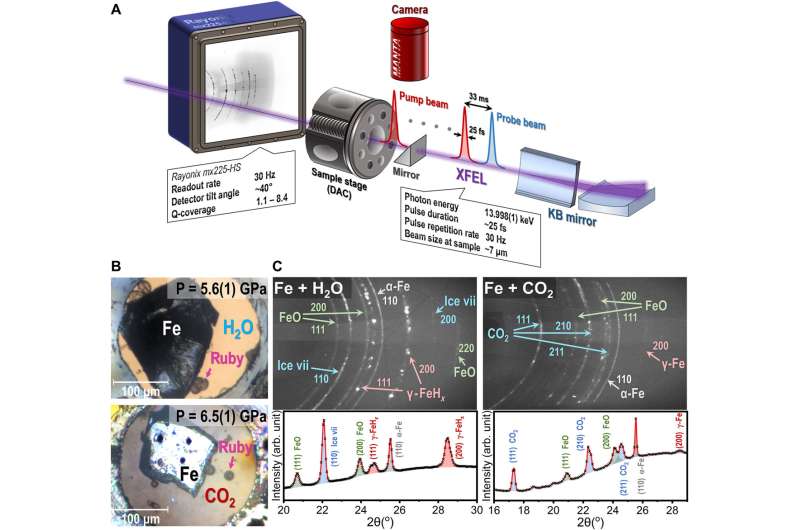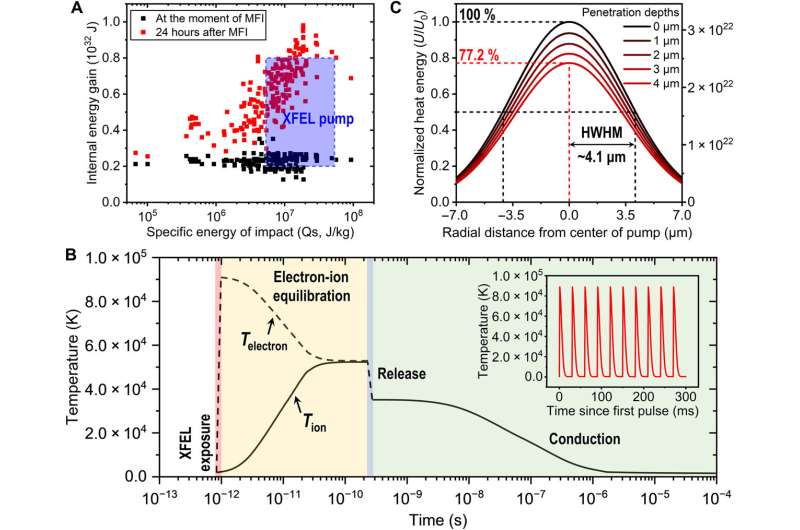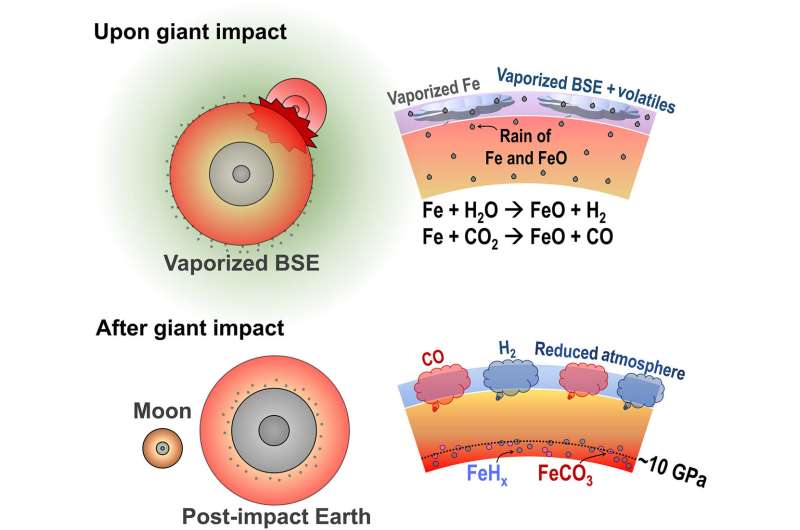December 20, 2023 feature
This article has been reviewed according to Science X's editorial process and policies. Editors have highlighted the following attributes while ensuring the content's credibility:
fact-checked
peer-reviewed publication
trusted source
proofread
Planetary scientists simulate oxidation of iron by giant impact during atmospheric evolution of early Earth

Giant-impact driven redox processes in the atmosphere and magma ocean may have played crucial roles during the evolution of the Earth. However, the absence of rock records from the time or era makes it challenging to understand these processes.
In a report published in Science Advances, Jinhuyuk Choi and a research team of planetary scientists in Seoul, Germany, and Korea, presented experimental results that can simulate giant impact-driven reactions between iron and volatiles, using X-ray free electron lasers.
The scientists used the X-ray free electron laser pump to oxidize iron to wüstite and reduced the volatiles to hydrogen and carbon monoxide. The iron oxidation proceeded to form hydrides and siderites to imply a redox boundary. The findings shed light on the process of creating a reduced atmosphere that underlies the emergence of prebiotic organic molecules on the early Earth.
Evolution of the Earth and the origin of life
The early giant impact that led to the formation of the moon more than 4.5 billion years ago was a catastrophic determinant in the evolution of the Earth. The global chemical mixing and redox process that occurred in the steam atmosphere and magma ocean due to this giant impact effect led to out-gassing and interim formation in the reduced atmosphere; a prerequisite to the origin of life.
While a variety of studies have proposed plausible scenarios underlying redox processes of the early mantle and atmosphere on Earth, researchers have attributed the formation of prebiotic organic species to the low oxygen fugacity of the planet. The Earth's mantle was oxidized to the present-day level since the Archean age to contain water, carbon dioxide, and nitrogen. To conduct numerical simulations that reproduce the early Earth conditions, the researchers needed to develop appropriate experimental methods to validate the giant impact-induced reactions.

The moon forming impact can have vaporized the bulk silicate Earth to form a steam atmosphere and expanded the magma ocean to cause global mixing between the materials from proto-Earth and the differentiated impactor. Planetary scientists postulate that the moon forming impact would have induced vigorous chemical reactions between the differentiated compounds of the impactor and proto-Earth—leading to early life.
X-ray free electron lasers as a structural probe
Since X-ray free electron lasers are the brightest artificial light source in the energy regime of X-rays produced from undulator magnets. The team incorporated laser-like ultrashort pulsed structures generated from self-amplified spontaneous emission.
In this work, Choi and colleagues used X-ray free electron lasers to pump and probe a pre-compressed mixture of heavy iron, and volatile water and carbon dioxide to simulate chemical reactions between the metallic core of the impactor, and volatiles present in the proto-Earth. The results provided experimental evidence for the giant impact-driven oxidation of iron, leading to the early evolutionary pathways required for the origin of life.
Simulating the giant impact-induced environment
During the experiments, the scientists used a variety of materials, and estimated the temperature of the iron foil upon irradiation by a single X-ray free electron laser pulse from the deposited energy to correspond to the pulse energy absorbed by the irradiated sample. The energy density increased the instant that pressure lasted picoseconds, by laser-shock compression.
While the difference in timescale between a giant impact and its experimental simulation still exist, the X-ray pump energy covered a large proportion of giant impact-driven conditions.

Choi and the team additionally determined the pressure and temperature from the X-ray probe pulse and determined the effect on the iron-water system. When the team probed the samples with an additional pulse sometime after each train pf pulses, the resulting reactions produced additional hydrogen as a secondary oxidation product.
Additionally, Choi and team conducted X-ray free electron lasers on the iron-carbon dioxide system, where ferrous oxide reacted further with CO2 to form siderite from consecutive pulses.
Microscopic observations of the recovered samples
The scientists gained further insights to the reaction pathway of the experiments after probing the cross sections of the recovered samples with focused ion beam and electron microscopy.
To understand the role of silicate on the giant impact-driven reactions, the team performed an in-situ laser-heating experiment on the iron-water-silicate system. They noted how the presence of silicate did not impact the oxidation of iron or the production of reduced species. While the amount of water and carbon dioxide on bulk silicate Earth before the moon forming impact was highly controversial, an assumption exists of the reactants fully participating in the giant impact-induced reactions.
Outlook
In this way, Jinhuyuk Choi and colleagues proposed a scheme for the giant impact-driven redox processes of the early atmosphere and Earth's mantle. They observed the extent of iron oxide formation and iron hydrogenation to be inversely correlated with pressure produced from the reaction between iron and water. The X-ray free electron laser pump-probe experiments on the pre-compressed iron, mixed with volatiles experimentally simulated giant impact-driven reactions in the magma ocean.
The research team estimated the amounts of oxidized iron species and reduced volatiles. The team supported the Theia hypothesis during the work, which describes a collision between proto-Earth and an astronomical body called Theia. The outcomes explained the temporal and global conformation of the oxidized mantle and reduced atmosphere to facilitate the emergence of life on early Earth.
More information: Jinhyuk Choi et al, Oxidation of iron by giant impact and its implication on the formation of reduced atmosphere in the early Earth, Science Advances (2023). DOI: 10.1126/sciadv.adi6096
Journal information: Science Advances
© 2023 Science X Network





















